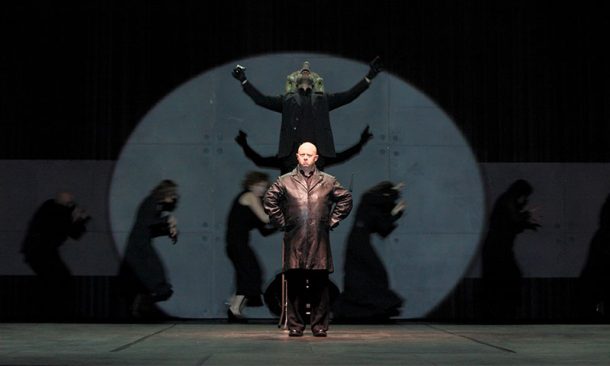Sibiu, where the third biggest international theatre festival in Europe takes place, is a city with approximately 150,000 citizens and constant cultural life, blossoming in the heart of Transylvania, Romania. The history of the city goes back to the Middle Ages, when it was established by German families as part of the Hungarian Empire. The old town is today’s downtown where the past and present meet, provoking mixed feelings for the visitors, though maybe not so mixed for the citizens already used to its magic. When walking around beautiful old buildings, observed by the eye-shaped windows on their roofs, in the small quiet streets leading to the crowded square, you could sense the spirit of the past. The peace and the calm whisper stories about years and ages ago. And, then after getting to the center, the same old buildings surrounded by hundreds of people start to live the life of today. It is a miracle how life in all its forms is bursting there.
But this state of being did not always exist in the city. Only twenty-five to thirty years ago it was small, forgotten, and gray. During the years of socialism, this province of Romania was not developing culturally or economically. In the 1980’s, Chaushesku started a special policy aimed at driving the Germans from the region out of the country. Even after the regime fell, the city didn’t change. The social and cultural life was the last to be developed. Due to the migration of the German portion of the national theatre, Radu Stanca, only one actor was left.
It was in this moment that the idea of establishing a festival dawned on Constantin Chiriac, an actor from the national theatre. The festival would be a meeting point for professionals from across the globe; a vast platform of cultures that would appear every year in front of the citizens’ eyes. The creation of the festival in 1993-94 was supported by many national and international theatre-makers; critics; professors, such as Silviu Purcarete, George Banu, and Noel Witts; and many more.
As time passed by the festival started to generate more and more interest, income and respect. Aware of what the power of culture could achieve, Mr. Chiriac started to build a whole cultural “castle” by using the festival as a basis. Nowadays the National Theatre, Radu Stanca, and the festival are under one roof. One of the reasons that the city was chosen as a European Capital of Culture in 2007, together with Luxemburg, was the success of the festival and the hard work of its creators.
Since then Sibiu has changed. The infrastructure has improved, the local businesses have started to expand, and the citizens have become more open and more engaged in theatre and culture in general. Today when you walk around the center during festival time, you can sense that the locals are real connoisseurs of theatre and the arts. Now Sibiu is a real kingdom of culture.
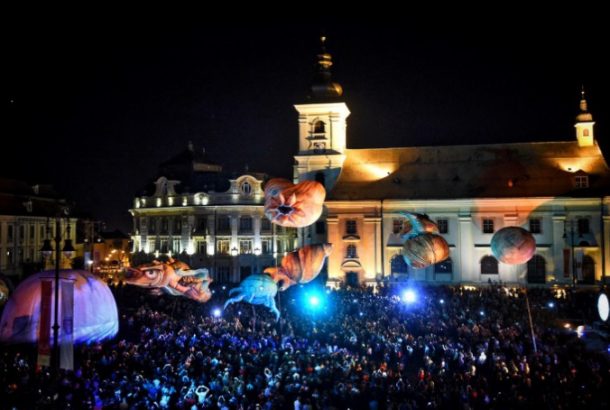
Sibiu International Theatre Festival. Photo: Sibiu Festival.
The festival takes place every June, and for ten days the city is full of people committed to the arts. There are a few sections of the program devoted to performing arts—theatre, dance, contemporary circus, readings of new drama, and outdoor theatre performances (other types are also added in some editions). The shows start after 2:00pm; before and after that time the program is full of conferences, discussions, workshops, seminars, book launches, and exhibitions.
The main aim of the festival’s program is to equally present theatre made by the “big” theatre-makers and by newcomers. Mr. Chiriac and his colleagues always say that the first criterion they have in mind is the quality of the performances. That’s why one could see many different genres and approaches at the festival. Over the years, some of the greatest directors of the twentieth century took part in the festival (including Peter Brook, Eugenio Barba, Peter Stein, and Ariane Mnouchkine) as well as some of the new faces of contemporary theatre such as Thomas Ostermeier, Oskaras Korsunovas, Eimuntas Nekrosius, and Alvis Hermanis. The great figures of Romanian theatre who have also worked abroad—Silviu Purcărete, Andrei Sherban, Mihai Maniutiu, and Gábor Tompa, among others—were and have been presented with their works too. Each year new names appear on the program. Contemporary dance and circus are well implemented. And every year brings representatives of the countries that have the biggest achievements in the fields (Israel, South Korea, Australia, Switzerland, Canada, Great Britain), alongside troupes from other countries.
The festival is a place where you can see traditional theatrical and performance such as Noh Theatre, Chinese opera, dance from Bali, and flamenco. The festival ensures that additional information about the artists and their way of working is provided by organizing projections of movies, exhibitions, conversations, and workshops. The educational part of the festival is very strong.
An important associated structure of the festival is the Sibiu Performing Arts Market, which is held for six days during the festival. The aim of the market is to be a place where cultural managers, festival curators, producers, and artists meet to present and view each others’ activities and to find opportunities for future collaboration. During the market, apart from the pitching sessions, there are workshops, seminars and working groups.
Another one of the Festival’s initiatives is the Sibiu Walk of Fame. It is dedicated to artists from across the country and the globe that have contributed to the cultural life in Sibiu. The walk lies in the city park with the city wall. It is a place to constantly remember and celebrate the importance of these people and their work.
The persons that receive a star are invited with one of their shows to the festival. One of the artists given a star this year was Rimas Tuminas who brought his extraordinary and touching interpretation of Thomas Bernhard’s play Minetti (a production of the Vakhtangov State Academic Theatre of Russia). The play tells the story of the old actor Minetti, who is waiting on New Year’s Eve for the theatre director who will invite him to play the role of King Lear again after many years. But as companions, Minetti (Vladimir Simonov) gets the staff of the hotel in which he is waiting, a troupe of actors who will perform as part the New Year’s Eve celebration, and an old lady (Liudmila Maksakova). The show is simultaneously about the actor’s faith in theatre and human destiny. Throughout life, one struggles and strives to perform the ROLE and sometimes the show is over before having even started. The stage design made by Adomas Jacovskis presents the lobby of the hotel where the New Year’s party is supposed to take place. The whole salon and furniture are black and the lighting is dim, as if it were a theatre venue before the beginning of a show. The feeling this atmosphere creates is not of a celebration to be held, but of an abandoned hotel where only ghosts from the past walk around.
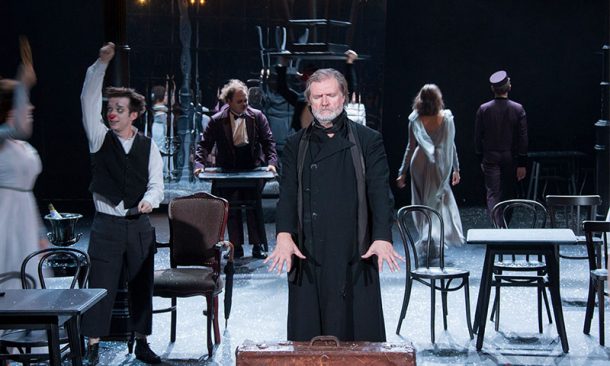
Rimas Tuminas, Minetti (Vakhtangov State Academic Theatre of Russia). Photo: Valeriy Miasnikov.
At times, Rimas Tuminas uses the characters surrounding Minetti to strengthen the parallels between acting and life and at other times to reduce the sad or melodramatic effect and provide sort of a “break.” The young actors who rehearse for the New Year’s Show appear and disappear as ghosts from Minetti’s youth or as symbols for states of life. The old and slightly scary lady could, for instance, be a sign of the approaching end. They appear as fantasies and unrealistic figures—one recites Shakespeare, another suffers from lovesickness, and as a choir they sing sad Russian songs.
The dark salon, the falling snow and cold wind correspond to Minetti’s mood. Instead of a meeting he gets only snow; instead of a new role and applause he gets a dark salon where guests (audience) don’t even appear; and instead of a new beginning only merciless wind is coming. In this atmosphere he can only remember and recall the past, the glorious times, and his youth, and while recalling all that he comes to certain conclusions about life. The performance is beautiful and empathetic. It makes one realize that the show has started from the moment of our birth, the role is indeed given to us then, and we have to perform as long as it’s possible.
Another of the Festival’s highlights was the very impressive and complex performance, Vangelo, a production of Emilia Romagna Teatro Fondazione created by Pippo Delbono, a winner of the Europe Theatre Prize for New Theatre Realities. In his signature style of mixing biographies, documentary stories, impressions, body expressions, quotes, and collages, and connecting scenes and stories with almost invisible yet existing relations, Delbono focuses on the topic of God and faith. Scenes don’t follow an overt logic: there are scenes in which Delbono tells stories about himself and his mom who asked him to create a show about Jesus and who insisted on him being religious as he was growing up; in other scenes footage of migrants, who share their stories from before they left their countries and from the migration itself, is presented on huge screens; and yet other scenes are quotes from other sources, such as Pina Bausch’s Seasons. The music is also a mixture of genres, from classical to modern. The production is like a storm of ideas centered on the main topic. It is political, religious, and sentimental, and afterwards one feels rich in stories and viewpoints and poor in words to express the power of Delbono’s creation.
Two of the new productions of the Radu Stanca National Theatre were also presented in the framework of the festival. The first one, Do you speak silence?, written and directed by Gianina Cărbunariu, is a continuation of the successful history of the theatre in the production political and documentary theatre. Along with Common People (also written and directed by Cărbunariu) Do you speak silence? focuses on some of the most painful problems for Eastern Europeans: corruption, standing against it, trying to remain faithful, and the difficult life of Gastarbeiters (foreign workers). With a strong sense of humanity and willingness not only to point out the problems but to open a discussion, Cărbunariu and her actors challenge the spectator to confront the situation and recognize its roots.
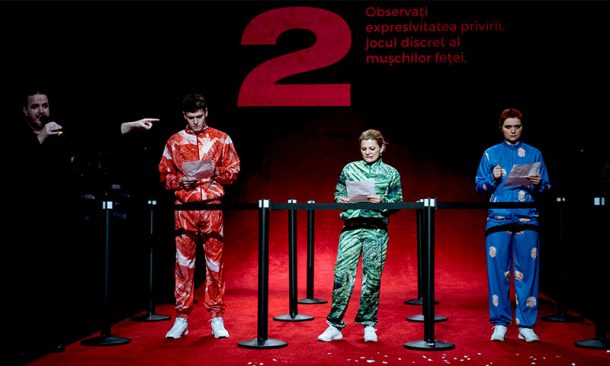
Gianina Cărbunariu, Do You Speak Silence?. Photo: Adrian Bulboacă.
Martyr, by Marius von Mayenburg, a production of the German section of the Radu Stanca National Theatre, directed by the famous Radu-Alexandru Nica, leaves a striking impression: the smooth actors work smoothly and it exudes a sense of faith and humanity. The well-known play about a school boy, Benjamin, who starts to use the Bible and Christian fundamentalism against everyone and everything, focuses on the conflict between tolerance and unbearableness, between prejudice and open-mindedness, and between caring and obduracy.
The playground on the stage works in a few ways. On one hand, it embodies the attitude of the others to the situation that Benjamin is creating: they don’t take seriously his behavior and treat his demands as a childish caprice with no engagement with the problem. On the other hand, the playground stands in contrast to the argument between Benjamin (Ali Deac) and his teacher (Alexandra Murăruș ) because there is nothing childish and innocent in Benjamin’s attitude or in the way he begins to treat other people and their beliefs. Ali Deac expresses the inner conflict and confusion of the boy by contrasting words with body language. The quotations Benjamin repeats are sometimes used as a way to control his body. We can tell by his slight shaking when his classmate Lydia touches him that he is not indifferent to sexuality. He then starts to quote. Benjamin’s need to rebel has gone too far, but he can’t go back and that deepens his problems. The path he turns to comes precisely from his unresolved problems and teenage complexes that no one except for the biology teacher pays attention to. Paradoxically, it’s his teacher who gets punished for her care because society tends to remain indifferent to sources of frustration, aggression, and lack of tolerance. Alexandra Murăruș imbues the character of the teacher with softness, kindness and determination. The ending of the performance is the cherry on the top of Nica’s production: it leaves us with a sense of hope—the speech of the teacher, full of determination and faith in people and goodness, ends with the act of nailing her own foot to the ground.
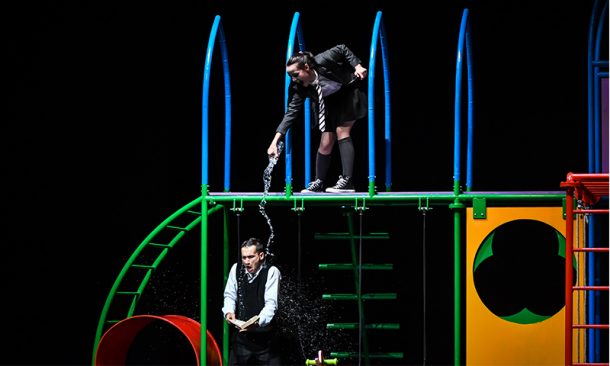
Marius von Mayenburg, Martyr (Radu Stanca National Theatre – German Section, Romania). Photo: Dragos Dumitru.
One of the programs in the festival is devoted to student productions and each year a number of theatre schools from Romania and around the world present their work. This program is a great opportunity for students not only to participate in a prestigious forum, but also to see some of the world’s great productions. During this year’s festival, one piece which was more like a work in progress stood out: My Self, a coproduction between Theatre Laboratory “Sfumato” (Sofia, Bulgaria), The National Academy of Theatre and Film Arts (Sofia, Bulgaria), and Pace School of Performing Arts (New York City, USA), directed by Margarita Mladenova and Ivan Dobchev. In this performance, the Bulgarian and American students are prompted to share significant memories and dreams of their experience. They perform in short scenes organised by topics such as childhood discoveries, sex, love, facing death, etc. The actors’ presence is very simple and dwells in a territory between storytelling and séance revealing. The search for the human archetypes and the ecstatic state is characteristic of the work of Mladenova and Dobchev. However, what is important this time is each person’s own experience as a base for finding the archetypes in their future works. What I found curious about this performance is that the Bulgarian students were the most willing to open up and share shocking, intense, and memorable stories. It is an interesting work that dwells in between the genres of theatre and performance.
The ten festival days passed quickly but remain unforgettable with all the good shows and emblematic meetings with artists. During these days one can’t forget for a second that one is at a festival—every third person you meet on the street has a festival badge, since from morning until late evening there are performances and concerts on the main square and around the city. Every guest of the city you happen to speak with is amazed by Sibiu and its spectacular festival.
Now, a few months later, a simple question is hovering my mind: if this year’s 24th edition was so impressive, what will the anniversary performance, in 2018, be like?
Emiliya Ilieva is a young theatre critic who holds a BA in Theatre Studies and Management (National Academy for Theatre and Film Arts, Sofia, Bulgaria). She has experience as a radio journalist and has collaborated on a few Bulgarian international festivals. Apart from theatre in all its forms, she’s interested in contemporary dance and cultural management.
European Stages, vol. 10, no. 1 (Fall 2017)
Editorial Board:
Marvin Carlson, Senior Editor, Founder
Krystyna Illakowicz, Co-Editor
Dominika Laster, Co-Editor
Kalina Stefanova, Co-Editor
Editorial Staff:
Taylor Culbert, Managing Editor
Nick Benacerraf, Editorial Assistant
Advisory Board:
Joshua Abrams
Christopher Balme
Maria Delgado
Allen Kuharsky
Bryce Lease
Jennifer Parker-Starbuck
Magda Romańska
Laurence Senelick
Daniele Vianello
Phyllis Zatlin
Table of Contents:
- The 2017 Avignon Festival: July 6 – 26, Witnessing Loss, Displacement, and Tears by Philippa Wehle
- A Reminder About Catharsis: Oedipus Rex by Rimas Tuminas, A Co-Production of the Vakhtangov Theatre and the National Theatre of Greece by Dmitry Trubochkin
- The Kunstenfestivaldesarts 2017 in Brussels by Manuel Garcia Martinez
- A Female Psychodrama as Kitchen Sink Drama: Long Live Regina! in Budapest by Gabriella Schuller
- Madrid’s Theatre Takes Inspiration from the Greeks by Maria Delgado
- A (Self)Ironic Portrait of the Artist as a Present-Day Man by Maria Zărnescu
- Throw The Baby Away With the Bath Water?: Lila, The Child Monster of The B*easts by Shastri Akella
- Report from Switzerland by Marvin Carlson
- A Cruel Theatricality: An Essay on Kjersti Horn’s Staging of the Kaos er Nabo Til Gud (Chaos is the Neighbour of God) by Eylem Ejder
- Szabolcs Hajdu & the Theatre of Midlife Crisis: Self-Ironic Auto-Bio Aesthetics on Hungarian Stages by Herczog Noémi
- Love Will Tear Us Apart (Again): Katie Mitchell Directs Genet’s Maids by Tom Cornford
- 24th Edition of Sibiu International Theatre Festival: Spectacular and Memorable by Emiliya Ilieva
- Almagro International Theatre Festival: Blending the Local, the National and the International by Maria Delgado
- Jess Thom’s Not I & the Accessibility of Silence by Zoe Rose Kriegler-Wenk
- Theatertreffen 2017: Days of Loops and Fog by Lily Kelting
- War Remembered Onstage at Reims Stages Europe: Festival Report by Dominic Glynn
Martin E. Segal Theatre Center:
Frank Hentschker, Executive Director
Marvin Carlson, Director of Publications
Rebecca Sheahan, Managing Director
©2016 by Martin E. Segal Theatre Center
The Graduate Center CUNY Graduate Center
365 Fifth Avenue
New York NY 10016
